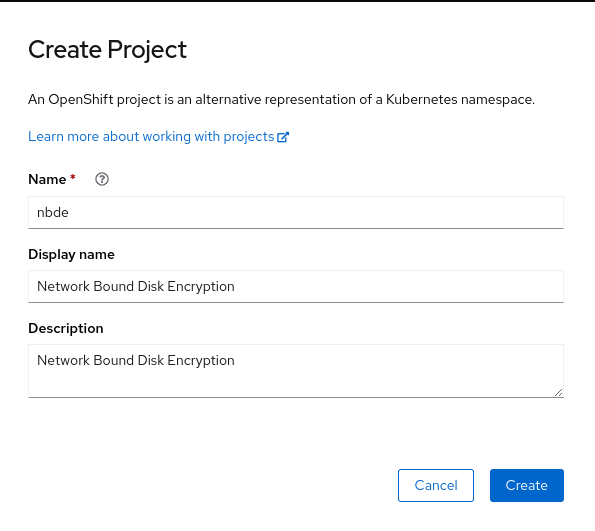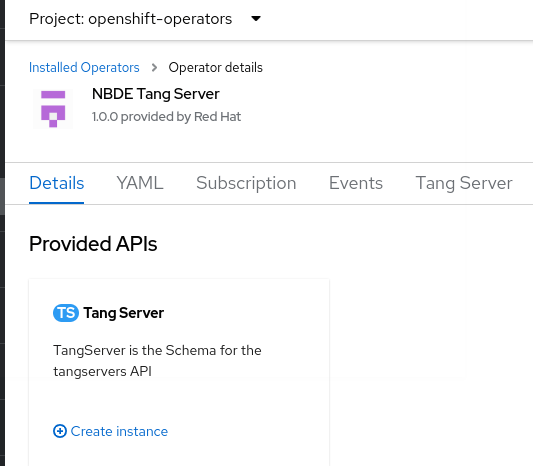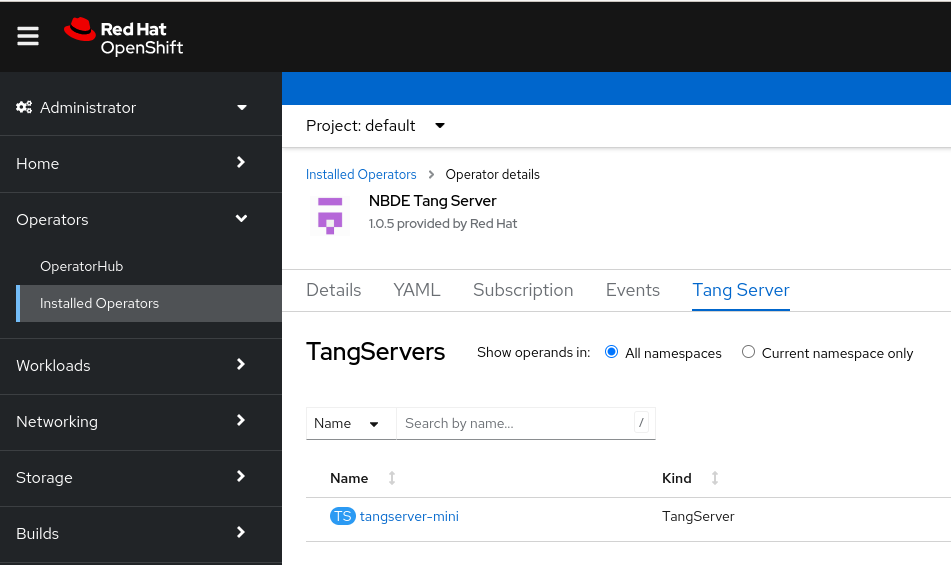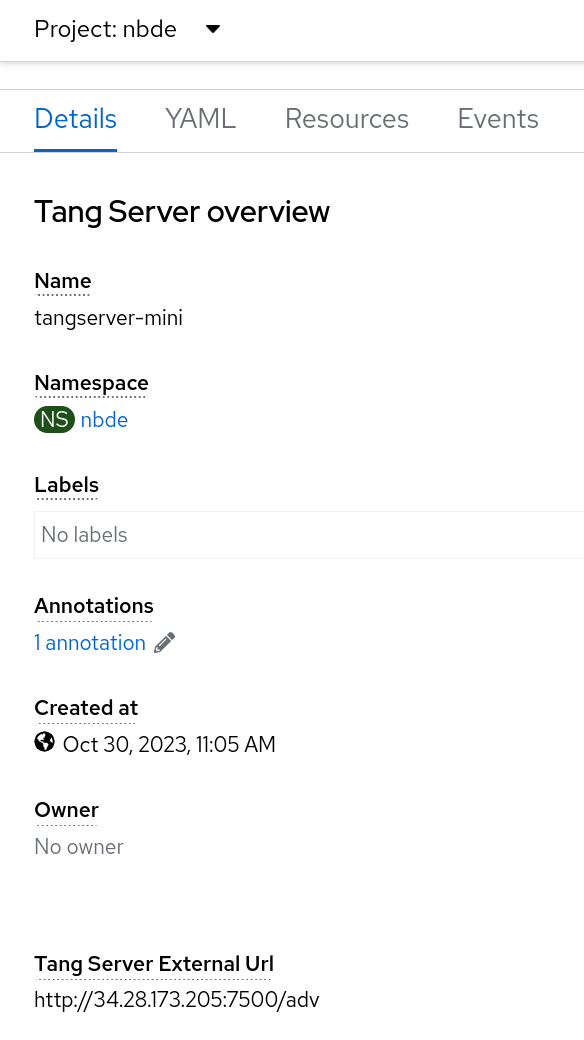Este contenido no está disponible en el idioma seleccionado.
Chapter 8. NBDE Tang Server Operator
8.1. NBDE Tang Server Operator overview
Network-bound Disk Encryption (NBDE) provides an automated unlocking of LUKS-encrypted volumes using one or more dedicated network-binding servers. The client side of NBDE is called the Clevis decryption policy framework and the server side is represented by Tang.
The NBDE Tang Server Operator allows the automation of deployments of one or several Tang servers in the OpenShift Container Platform (OCP) environment.
8.2. NBDE Tang Server Operator release notes
The following release notes track the development of the NBDE Tang Server Operator in OpenShift Container Platform.
- RHEA-2023:7491
- The NBDE Tang Server Operator 1.0 has been released in the Red Hat OpenShift Enterprise 4 catalog.
- RHEA-2024:0854
-
The NBDE Tang Server Operator 1.0.1 has been moved from the
alphachannel to thestablechannel. - RHBA-2024:8681
- The 1.0.2 update contains fixes that increase the Container Health Index of containers deployed with the NBDE Tang Server Operator to the highest grade.
- RHEA-2024:10970
- The 1.0.3 update contains changes that re-increase the Container Health Index to the highest grade.
- RHBA-2025:0663
-
The NBDE Tang Server Operator 1.1 includes the
golangpackage version 1.23.2 and thegolang.org/x/net/htmlpackage version 0.33.0. The updates improve the Container Health Index. - RHBA-2025:4453
- The 1.1.1 update provides a fix for CVE-2025-22866.
8.3. Understanding the NBDE Tang Server Operator
You can use the NBDE Tang Server Operator to automate the deployment of a Tang server in an OpenShift Container Platform cluster that requires Network Bound Disk Encryption (NBDE) internally, leveraging the tools that OpenShift Container Platform provides to achieve this automation.
The NBDE Tang Server Operator simplifies the installation process and uses native features provided by the OpenShift Container Platform environment, such as multi-replica deployment, scaling, traffic load balancing, and so on. The Operator also provides automation of certain operations that are error-prone when you perform them manually, for example:
- server deployment and configuration
- key rotation
- hidden keys deletion
The NBDE Tang Server Operator is implemented using the Operator SDK and allows the deployment of one or more Tang servers in OpenShift through custom resource definitions (CRDs).
8.4. Installing the NBDE Tang Server Operator
You can install the NBDE Tang Operator either by using the web console or through the oc command from CLI.
8.4.1. Installing the NBDE Tang Server Operator using the web console
You can install the NBDE Tang Server Operator from the OperatorHub using the web console.
Prerequisites
-
You must have
cluster-adminprivileges on an OpenShift Container Platform cluster.
Procedure
-
In the OpenShift Container Platform web console, navigate to Operators
OperatorHub. Search for the NBDE Tang Server Operator:
- Click Install.
- On the Operator Installation screen, keep the Update channel, Version, Installation mode, Installed Namespace, and Update approval fields on the default values.
After you confirm the installation options by clicking Install, the console displays the installation confirmation.
Verification
-
Navigate to the Operators
Installed Operators page. Check that the NBDE Tang Server Operator is installed and its status is
Succeeded.
8.4.2. Installing the NBDE Tang Server Operator using CLI
You can install the NBDE Tang Server Operator from the OperatorHub using the CLI.
Prerequisites
-
You must have
cluster-adminprivileges on an OpenShift Container Platform cluster. -
You have installed the OpenShift CLI (
oc).
Procedure
Use the following command to list available Operators on OperatorHub, and limit the output to Tang-related results:
oc get packagemanifests -n openshift-marketplace | grep tang
$ oc get packagemanifests -n openshift-marketplace | grep tangCopy to Clipboard Copied! Toggle word wrap Toggle overflow Example output
tang-operator Red Hat
tang-operator Red HatCopy to Clipboard Copied! Toggle word wrap Toggle overflow In this case, the corresponding packagemanifest name is
tang-operator.Create a
Subscriptionobject YAML file to subscribe a namespace to the NBDE Tang Server Operator, for example,tang-operator.yaml:Example subscription YAML for tang-operator
Copy to Clipboard Copied! Toggle word wrap Toggle overflow - 1
- Specify the channel name from where you want to subscribe the Operator.
- 2
- Specify the name of the Operator to subscribe to.
- 3
- Specify the name of the CatalogSource that provides the Operator.
- 4
- The namespace of the CatalogSource. Use
openshift-marketplacefor the default OperatorHub CatalogSources.
Apply the
Subscriptionto the cluster:oc apply -f tang-operator.yaml
$ oc apply -f tang-operator.yamlCopy to Clipboard Copied! Toggle word wrap Toggle overflow
Verification
Check that the NBDE Tang Server Operator controller runs in the
openshift-operatorsnamespace:oc -n openshift-operators get pods
$ oc -n openshift-operators get podsCopy to Clipboard Copied! Toggle word wrap Toggle overflow Example output
NAME READY STATUS RESTARTS AGE tang-operator-controller-manager-694b754bd6-4zk7x 2/2 Running 0 12s
NAME READY STATUS RESTARTS AGE tang-operator-controller-manager-694b754bd6-4zk7x 2/2 Running 0 12sCopy to Clipboard Copied! Toggle word wrap Toggle overflow
8.5. Configuring and managing Tang servers using the NBDE Tang Server Operator
With the NBDE Tang Server Operator, you can deploy and quickly configure Tang servers. On the deployed Tang servers, you can list existing keys and rotate them.
8.5.1. Deploying a Tang server using the NBDE Tang Server Operator
You can deploy and quickly configure one or more Tang servers using the NBDE Tang Server Operator in the web console.
Prerequisites
-
You must have
cluster-adminprivileges on an OpenShift Container Platform cluster. - You have installed the NBDE Tang Server Operator on your OCP cluster.
Procedure
-
In the OpenShift Container Platform web console, navigate to Operators
OperatorHub. Select Project, and click Create Project:
On the
Create Projectpage, fill in the required information, for example:- Click Create.
NBDE Tang Server replicas require a Persistent Volume Claim (PVC) for storing encryption keys. In the web console, navigate to Storage
PersistentVolumeClaims: -
On the following
PersistentVolumeClaimsscreen, click Create PersistentVolumeClaim. On the
Create PersistentVolumeClaimpage, select a storage that fits your deployment scenario. Consider how often you want to rotate the encryption keys. Name your PVC and choose the claimed storage capacity, for example:-
Navigate to Operators
Installed Operators, and click NBDE Tang Server. Click Create instance.
On the
Create TangServerpage, choose the name of the Tang Server instance, amount of replicas, and specify the name of the previously created Persistent Volume Claim, for example:- After you enter the required values a change settings that differ from the default values in your scenario, click Create.
8.5.2. Rotating keys using the NBDE Tang Server Operator
With the NBDE Tang Server Operator, you also can rotate your Tang server keys. The precise interval at which you should rotate them depends on your application, key sizes, and institutional policy.
Prerequisites
-
You must have
cluster-adminprivileges on an OpenShift Container Platform cluster. - You deployed a Tang server using the NBDE Tang Server Operator on your OpenShift cluster.
-
You have installed the OpenShift CLI (
oc).
Procedure
List the existing keys on your Tang server, for example:
oc -n nbde describe tangserver
$ oc -n nbde describe tangserverCopy to Clipboard Copied! Toggle word wrap Toggle overflow Example output
Copy to Clipboard Copied! Toggle word wrap Toggle overflow Create a YAML file for moving your active keys to hidden keys, for example,
minimal-keyretrieve-rotate-tangserver.yaml:Example key-rotation YAML for tang-operator
Copy to Clipboard Copied! Toggle word wrap Toggle overflow - 1
- Specify the SHA-1 thumbprint of your active key to rotate it.
Apply the YAML file:
oc apply -f minimal-keyretrieve-rotate-tangserver.yaml
$ oc apply -f minimal-keyretrieve-rotate-tangserver.yamlCopy to Clipboard Copied! Toggle word wrap Toggle overflow
Verification
After a certain amount of time depending on your configuration, check that the previous
activeKeyvalue is the newhiddenKeyvalue and theactiveKeykey file is newly generated, for example:oc -n nbde describe tangserver
$ oc -n nbde describe tangserverCopy to Clipboard Copied! Toggle word wrap Toggle overflow Example output
Copy to Clipboard Copied! Toggle word wrap Toggle overflow
8.6. Identifying URL of a Tang server deployed with the NBDE Tang Server Operator
Before you can configure your Clevis clients to use encryption keys advertised by your Tang servers, you must identify the URLs of the servers.
8.6.1. Identifying URL of the NBDE Tang Server Operator using the web console
You can identify the URLs of Tang servers deployed with the NBDE Tang Server Operator from the OperatorHub by using the OpenShift Container Platform web console. After you identify the URLs, you use the clevis luks bind command on your clients containing LUKS-encrypted volumes that you want to unlock automatically by using keys advertised by the Tang servers. See the Configuring manual enrollment of LUKS-encrypted volumes section in the RHEL 9 Security hardening document for detailed steps describing the configuration of clients with Clevis.
Prerequisites
-
You must have
cluster-adminprivileges on an OpenShift Container Platform cluster. - You deployed a Tang server by using the NBDE Tang Server Operator on your OpenShift cluster.
Procedure
-
In the OpenShift Container Platform web console, navigate to Operators
Installed Operators Tang Server. On the NBDE Tang Server Operator details page, select Tang Server.
- The list of Tang servers deployed and available for your cluster appears. Click the name of the Tang server you want to bind with a Clevis client.
The web console displays an overview of the selected Tang server. You can find the URL of your Tang server in the
Tang Server External Urlsection of the screen:In this example, the URL of the Tang server is
http://34.28.173.205:7500.
Verification
You can check that the Tang server is advertising by using
curl,wget, or similar tools, for example:curl 2> /dev/null http://34.28.173.205:7500/adv | jq
$ curl 2> /dev/null http://34.28.173.205:7500/adv | jqCopy to Clipboard Copied! Toggle word wrap Toggle overflow Example output
{ "payload": "eyJrZXlzIj…eSJdfV19", "protected": "eyJhbGciOiJFUzUxMiIsImN0eSI6Imp3ay1zZXQranNvbiJ9", "signature": "AUB0qSFx0FJLeTU…aV_GYWlDx50vCXKNyMMCRx" }{ "payload": "eyJrZXlzIj…eSJdfV19", "protected": "eyJhbGciOiJFUzUxMiIsImN0eSI6Imp3ay1zZXQranNvbiJ9", "signature": "AUB0qSFx0FJLeTU…aV_GYWlDx50vCXKNyMMCRx" }Copy to Clipboard Copied! Toggle word wrap Toggle overflow
8.6.2. Identifying URL of the NBDE Tang Server Operator using CLI
You can identify the URLs of Tang servers deployed with the NBDE Tang Server Operator from the OperatorHub by using the CLI. After you identify the URLs, you use the clevis luks bind command on your clients containing LUKS-encrypted volumes that you want to unlock automatically by using keys advertised by the Tang servers. See the Configuring manual enrollment of LUKS-encrypted volumes section in the RHEL 9 Security hardening document for detailed steps describing the configuration of clients with Clevis.
Prerequisites
-
You must have
cluster-adminprivileges on an OpenShift Container Platform cluster. -
You have installed the OpenShift CLI (
oc). - You deployed a Tang server by using the NBDE Tang Server Operator on your OpenShift cluster.
Procedure
List details about your Tang server, for example:
oc -n nbde describe tangserver
$ oc -n nbde describe tangserverCopy to Clipboard Copied! Toggle word wrap Toggle overflow Example output
Copy to Clipboard Copied! Toggle word wrap Toggle overflow -
Use the value of the
Service External URL:item without the/advpart. In this example, the URL of the Tang server ishttp://34.28.173.205:7500.
Verification
You can check that the Tang server is advertising by using
curl,wget, or similar tools, for example:curl 2> /dev/null http://34.28.173.205:7500/adv | jq
$ curl 2> /dev/null http://34.28.173.205:7500/adv | jqCopy to Clipboard Copied! Toggle word wrap Toggle overflow Example output
{ "payload": "eyJrZXlzIj…eSJdfV19", "protected": "eyJhbGciOiJFUzUxMiIsImN0eSI6Imp3ay1zZXQranNvbiJ9", "signature": "AUB0qSFx0FJLeTU…aV_GYWlDx50vCXKNyMMCRx" }{ "payload": "eyJrZXlzIj…eSJdfV19", "protected": "eyJhbGciOiJFUzUxMiIsImN0eSI6Imp3ay1zZXQranNvbiJ9", "signature": "AUB0qSFx0FJLeTU…aV_GYWlDx50vCXKNyMMCRx" }Copy to Clipboard Copied! Toggle word wrap Toggle overflow










